December 5, 2008
Air Date: December 5, 2008
FULL SHOW
SEGMENTS
New Direction for EPA
/ Jeff YoungView the page for this story
The president-elect promised change but changing the Environmental Protection Agency might be a tough job. Living on Earth’s Jeff Young spoke with some EPA veterans who describe an agency beset by low morale, weak enforcement, and political meddling in science. And they warn that turning it around will take much more than changing a few people at the top. (06:30)
Marianas National Marine Monument
View the page for this story
With a little more than a month left in office, President Bush still has a chance to leave a blue-green legacy. That’s if he declares 150,000 square miles of the Pacific Ocean a marine monument. Andrew Salas, vice chair of Friends of the Monument, tells host Bruce Gellerman that the area, which includes his homeland in the Northern Mariana Islands, has a wide and beautiful diversity of marine life that deserves protection. (05:30)
Ethanol’s Bumpy Ride
View the page for this story
The U.S. ethanol industry has had the pedal to the metal - until recently. Now some ethanol companies may be about to stall out. Jim Lane, chairman of the American Biofuels Council, tells host Bruce Gellerman about ethanol’s change in fortune. (06:30)
Fungal Fuel
/ Jessie MartinView the page for this story
Scientists have discovered a fungus from the Patagonian rainforest that produces hydrocarbons much like those found in diesel fuel. Jessie Martin reports. (02:10)
The Sea Superhighway
View the page for this story
The Gulf Stream is an important ocean current that surges northward along the eastern coast of North America. It has had a tremendous influence on climate, marine life and early exploration of the New World. In his new book, "The Gulf Stream: Tiny Plankton, Giant Bluefin, and the Amazing Story of the Powerful River in the Atlantic," Stan Ulanski, a geology professor at James Madison University, shares the story of the mighty Gulf Stream, past and present. (09:00)
After War, Wind-Powered Radio
View the page for this story
In Southern Sudan electricity is virtually non-existent after 22 years of civil war. Host Bruce Gellerman talks with Internews program director Deborah Ensor about bringing solar and wind energy to the region to power a new radio station. (07:30)
Toy Toxicity
View the page for this story
Before heading to the toy store this year Jeff Gearhart from the Ecology Center tells host Bruce Gellerman that parents should learn about the harmful chemicals that might be in some children’s toys. His group tested 1500 toys and discovered that a third of them were toxic. (04:00)
A Wild Xmas
View the page for this story
Snapping shrimp, a mountain gorilla, dolphins and frogs: these are just some of the animal voices used in the album “A Wild Christmas.” Sound engineer Bernie Krause dipped into his enormous archive of sounds from the wild and orchestrated them into a compilation of holiday tunes. Special guest solo by Molly the parrot! (04:30)
Show Credits and Funders
Show Transcript
Host: Bruce Gellerman
Guests: Deborah Ensor, Jeff Gearhart, Bernie Krauss, Jim Lane, Andrew Salas, Stan Ulanski
Reporters: Jeff Young
[THEME]
GELLERMAN: From Public Radio International, this is Living on Earth.
[THEME]
GELLERMAN: I’m Bruce Gellerman. The new head of the U.S. Environmental Protection Agency will face a tough job cleaning up the environment and the Agency itself.
RUCH: What I hear from employees is they’re ashamed to tell their neighbors and friends where they work because they’re asked what they’re doing about global warming and have to admit they’re doing nothing. And to them it’s quite distressing.
GELLERMAN: Also – delivering radio’s power to the people…where there is no power.
ENSOR: There’s no infrastructure in south Sudan, which means there’s no electricity, so in some of our stations we use solar and wind power.
GELLERMAN: Radio and renewable power help renew a society destroyed by decades of civil war.
And …
[MUSIC:"'Tis the Season..."]
GELLERMAN: … nature’s sounds create seasonal songs. These stories and more, this week on Living on Earth. Join the choir.
ANNOUNCER: Support for Living on Earth comes from the National Science Foundation and Stonyfield Farm.
New Direction for EPA
GELLERMAN: From the Jennifer and Ted Stanley studios in Somerville, Massachusetts, this is Living on Earth. I’m Bruce Gellerman, in for Steve Curwood.
President-elect Barack Obama is wasting no time assembling his cabinet, but still to be named is his choice to head up the Environmental Protection Agency.
Under the Bush presidency, the EPA has been a constant source of controversy. Allegations of lax enforcement, and manipulation of scientific studies sparked fights in Congress and lawsuits before the nation’s highest court. Living on Earth’s Jeff Young has a look at what’s happened to the agency and the job that lies ahead for the next EPA chief.
YOUNG: You didn’t have to follow the news to know the Environmental Protection Agency had an image problem—all you had to do was watch the Simpson’s movie. The villain was the head of the EPA.
SIMPSONS EXCERPT: Cargill: I’ve narrowed your choices down to five options. President: “I need to know what I’m approving” Cargill: “knowing things is overrated!”
YOUNG: How did one of the world’s premiere environmental agencies become the punch line to a pop culture joke? Many who worked in EPA say eight years of the Bush Administration left an agency with a disregard for science, a discouraged workforce, and decreased enforcement of laws meant to protect the air, water and public health. And both those who criticize the agency and defend it agree it will not be easy for President Obama’s new leaders to change things.
SCHAEFFER: Well, the Bush administration’s been around for eight years and their agenda was pretty radical, and it does mean the Obama administration will have some work turning the ship around. It’s not simply a matter of replacing a few people at the top.
YOUNG: That’s Eric Schaeffer, who joined EPA under the first President Bush. As head of Civil Enforcement, Schaeffer led efforts to clean up refineries and power plants. But early in 2001 he realized this President Bush was taking the agency in a different direction.
SCHAEFFER: You got this kind of sick feeling in the pit of your stomach that facts were not going to matter. And that science wasn’t really going to have much place in the discussion, this was very political.
YOUNG: Schaeffer quit and started a private watchdog group called Environmental Integrity Project, hounding the Agency on things like changes to the clean air act, a weak mercury emissions rule, and inaction on global warming. Courts eventually threw out most of the Bush EPA proposals. But Schaeffer says even when the Bush EPA lost, it won.
SCHAEFFER: These battles are mostly about buying time. For a lot of these guys, they’re smart enough to know they’re gonna lose. But they benefit from the game. The game is, put a bad rule forward and even if it loses, it will buy us five, six, seven years until we have to comply with the standard. That is a victory.
YOUNG: That’s the sort of thing the Obama transition team is now hearing about. The team is led by Carol Browner, who led the EPA for much of the 90s under President Clinton.
BROWNER: I think that the last eight years was not just about inattention it wasn’t
like they were just sort of not doing anything, they were actively looking at how to change the decision-making paradigm to move it away from historic "protect the public health, protect the public welfare," whatever statutes that EPA has responsibility for, they managed to change the fundamentals of every single one of them.
YOUNG: Browner has high praise for EPA workers. But there are signs of trouble there, too. A survey by the Union of Concerned Scientists found nearly 900 EPA scientists around the country said they had felt political interference in their work.
Jeff Ruch runs a group called PEER, Public Employees for Environmental Responsibility, which he calls a giant shelter for battered government workers. Ruch heard a lot from EPA’s workers. Some were upset that the agency closed some of its world-class research libraries.
RUCH: At one point I got a call from an anguished librarian on a cell phone and he’d been ordered to recycle volumes and he was saving them in the cafeteria, and wanted to know what his rights were.
YOUNG: Ruch says morale got so low that unions representing thousands of EPA workers sent an unprecedented letter to Administrator Stephen Johnson accusing him of violating their trust. The letter cited the agency head’s decision to ignore staff advice on the question of regulating greenhouse gases.
RUCH: What I hear from employees, is they’re ashamed to tell their neighbors and friends where they work because they’re asked what they’re doing about global warming and they have to admit they’re doing nothing. They’re facing in their minds the biggest environmental crisis of their lifetimes and they’re not allowed to work on it. And to them it’s quite distressing.
YOUNG: Ruch says low morale worsens workforce losses already underway because many EPA workers are reaching retirement age. It’s something EPA engineer Hugh Kaufman sees firsthand. Kaufman joined EPA at its creation and calls the Bush years an attempt to destroy the agency.
KAUFMAN: The preponderance of people brought in to the agency over the last eight years were basically a very sophisticated wrecking crew. And so the old timers have taken early retirement or left, and basically EPA has been hollowed out. So the agency is going to have to be rebuilt.
YOUNG: EPA Administrator Johnson was not available for comment for this story. One of his former deputies defended the Bush EPA. Jeff Holmstead led EPA’s air office under Bush for five years. He was responsible for many of the decisions that critics say favored industry over the environment.
HOLMSTEAD: I guess I have to say I kind of resent the premise of your question that somehow if something is good for industry it has to be bad for the environment. That’s just not true.
YOUNG: Holmstead says the Bush EPA pushed for two of the biggest public health victories in the agency’s history: a clean air rule to limit power plant emissions and a cleanup of off-road diesel engines. And Holmstead has a warning for the new EPA team if it wants to get rid of rules and procedures he helped put in place.
HOLMSTEAD: It’s not nearly as easy as you think. The regulatory apparatus is cumbersome. And it’s unrealistic to think anyone can come in and just immediately change things around, that’s not the way the system is designed to work.
YOUNG: EPA veterans Eric Schaeffer and Hugh Kaufman say that’s why Obama should appoint someone strong and savvy who can shake things up. But the man who campaigned on a message of change may find EPA a tough place to make change happen.
For Living on Earth, I’m Jeff Young in Washington.
Related links:
- Public Employees for Environmental Responsibility
- Union of Concerned Scientists
- Environmental Integrity Project
Marianas National Marine Monument
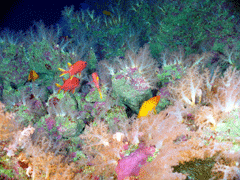
Soft corals and tropical fish on the summit of an underwater volcano in the Mariana Islands. (Courtesy of the NOAA Submarine Ring of Fire 2004 Exploration and the NOAA Vents Program)
GELLERMAN: With just a few weeks left to his term as president, George W. Bush is seeking to burnish a blue-green legacy.
Two years ago, Mr. Bush put 140,000 square miles of Pacific Ocean, north of Hawaii, off limits to oil drilling and fishing. Now, the President hopes to protect another vast area of the ocean – this one 4,000 miles west of Hawaii. It includes three of the remote Northern Mariana Islands and the Mariana Trench, the deepest spot in the ocean – a gash in the earth’s crust nearly seven miles down. The proposal has some influential supporters - including first lady Laura Bush - and prominent opponents. Among those trying to sink the President’s plan to create this National Marine Monument is Vice President Dick Cheney, and nearly all of the elected officials of Micronesia.
But many residents want to win federal protection, including Andrew Salas, vice president of the organization Friends of the Monument. Mr. Salas, welcome!
SALAS: Thank you.
GELLERMAN: Which three islands are we talking about?
SALAS: Maug, Asuncion, and Uracus. The water surrounding those three islands.
GELLERMAN: So how many square miles we talking here?
SALAS: About 115,000.
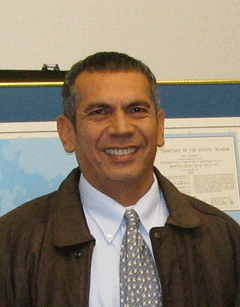
Mr. Andrew Salas, vice president of Friends of the Monument and former congressman of the Commonwealth of the Northern Marianas Islands.
GELLERMAN: I gotta tell you, the one that was named two years ago is 140,000.
SALAS: That’s the reason why we came to D.C. This is my first trip to D.C., and I want to ask the good president to please make it bigger than the Islands in Hawaii.
GELLERMAN: So how much bigger?
SALAS: Maybe an inch bigger. [LAUGHS]
GELLERMAN: So those are kinda bragging rights?
SALAS: Yes sir. Nobody ever remembers second place in the World Series or the second place at the Super Bowl. Always remember the champ.
GELLERMAN: Well how would that help the people of Northern Marianas?
SALAS: Well you know, you know, have you ever been to the Northern Marianas islands?
GELLERMAN: No, I haven’t.
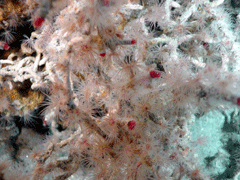
A close-up of the tubeworm found at two volcanoes in the Northern Mariana Islands. (Courtesy of the NOAA Submarine Ring of Fire 2004 Exploration and the NOAA Vents Program)
GELLERMAN: Mr. Salas, what would protection under this marine reserve do for the area?
SALAS: Well, for one, you know, those three islands are – they’re about 300 miles from Saipan. Right now we don’t have the means – it is protected by constitution, but we do not have the means to patrol that area and protect it. As a matter of fact, maybe seven or eight weeks ago, we caught a Taiwanese ship poaching in our waters. So, at the most basic, fundamental protection is at least to keep outsiders away from our islands and to stop poaching our fish in our waters. Look at what’s happening with the fish stocks all over the world. This will provide an area where fish can be protected and when they get big they can lay an abundance of eggs and they can go out, outside the protected areas and everybody can benefit from it.
GELLERMAN: Strange – I mean here you’ve got Laura Bush and the President supporting this and they’re being opposed by the Vice President Cheney.

Soft corals and tropical fish on the summit of an underwater volcano in the Mariana Islands. (Courtesy of the NOAA Submarine Ring of Fire 2004 Exploration and the NOAA Vents Program)
SALAS: [Laugh] Well, it’s not a perfect world, but we try our best, you know. The governor of the commonwealth thinks of this as another federal intrusion and it’s not. In our possession today we have original copies of over 6,000 signatures from our people from our beautiful commonwealth that sign in support of this monument.
GELLERMAN: Mr. Salas, what was this place like when you were young?
SALAS: Ah, it was beautiful. And that’s why we – you know, Beach Road is our main road, our primary road when I was growing up. And when the fish would come into the lagoon, our blue water became really dark. And every islander that was passing by, whether driving, bicycling or walking, all they had to do was come up to the beach and they get a coffee can full of whatever fish was in the lagoon. But now you gotta go miles to fish. And we’re hoping that President Bush takes the time to make a bold move to declare it a marine monument so that the people of the commonwealth can have a place where young people can remember, like I remember, thirty years ago, forty years ago, about the beauty of our lagoon on Beach Road.
GELLERMAN: Well Mr. Salas, I want to thank you very much.
SALAS: Thank you sir. It was my pleasure.
GELLERMAN: Andrew Salas is vice president of Friends of the Monument – a group seeking protection for the Northern Mariana Islands.
Related links:
- Friends of the Monument
- The Pew Center supports the Friends of the Monument
[MUSIC: Senor Coconut “Moscow Discow” from Around The World (Nacional Records 2008)]
GELLERMAN: Just ahead – the economy hits the brakes, sending ethanol producers into a skid. Keep listening to Living on Earth!
Ethanol’s Bumpy Ride
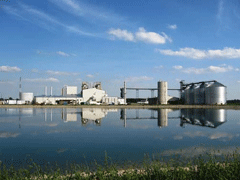
Poetethanol. Poet, the largest privately-held ethanol producer.
GELLERMAN: It’s Living on Earth, I’m Bruce Gellerman. It was just a few months ago that the ethanol industry was in high gear. With the price for gas at the pump soaring, the demand for ethanol – a fuel substitute made mostly from corn - was sky high, making corn growers and ethanol producers very happy and consumers very sad.
Well, what a difference a few weeks make. The economy has taken a sudden turn for the worse driving the demand for gas and ethanol into a ditch. Jim Lane is editor of the online daily “Biofuels Digest.” Mr. Lane, it’s always good to talk with you.
LANE: Good to be here.
GELLERMAN: You know until recently, the ethanol biz had been booming. What - just last year the number of ethanol processing plants in the U.S. increased by sixty percent.
LANE: That’s true. It was a boom business. And it’s still booming in terms of supply. There’s plenty of capacity coming on line, but it’s hard to make it a business these days. 15 percent are already in bankruptcy of the ethanol supply in the country, and that’s really a function of the economics of the business, because it’s the spread between the price of the feedstock which is usually corn. And that’s gone up and down a lot this year. It’s caused a lot of dislocation, and of course it’s capital-intensive business. It costs a lot of money to put an ethanol plant together and it’s tough to find capital in these strange economic times that we find ourselves in.
GELLERMAN: Seems like its feast or famine. The corn prices were two bucks a bushel, then they went to eight dollars a bushel and now they’re down to three, three-and-a-half dollars.
LANE: Yeah, they were at two for a long time – forty years at two. And they did take a large leap into the seven, eight dollar range. They had more to do with the fact that there was a real big crop failure in Europe and a lot of speculative money also moved into the market in the spring, so it was temporary, but boy it was tough. And a lot of these ethanol producers got scared, locked in when they saw prices at around six dollars and said, hey let’s, let’s go for that. Well, now they’re down to three fifty and that’s why they’re declaring bankruptcy left, right and center.
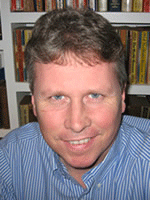
Jim Lane (Courtesy of Jim Lane)
GELLERMAN: Ah, so they bought it high and now they gotta sell it low.
LANE: That’s right. The price of ethanol – you can get ethanol, a gallon of ethanol in Sacramento for $1.19 a gallon for E 85, it’s 85% ethanol. And you just can’t make a business when it’s about $1.05 just for the corn, so, without anything else.
GELLERMAN: Well the debate this summer when prices were really high was the question of, “Can we feed and fuel the country with corn?”
LANE: Yeah, that was a very big debate this summer, food vs. fuel. And a lot of people said that the increase in the use of corn for fuel was what was causing the price increase, well, of food and other items. I think we have a good answer on that right now because the price of most grains are down 50 to 60 percent - soy, wheat and corn – but the price of the, a basket of goods at the supermarket has not gone down yet. So there is some linkage, but it’s a very, very weak link. Certainly, we’re gonna grow our food stock first and with the residual land we’re going to produce fuel and energy crops. But we also can use a lot of the litter and the agricultural residue that has never been used properly - can be used to make fuel. So, it’s kind of a one plus one equals three situation if you get it right, and that’s where the industry is heading and we certainly expect to be there in the next few years.
GELLERMAN: So you mean moving away from corn and sugar and using others and creating cellulosic ethanol.
LANE: It’s happening right now. They’ve been at the pilot stage and the demonstration scale for some time, but the first plants at the 100,000,000-gallon level will be opening in around 2010 or 2011. And those will be using all kinds of residues. They use municipal solid waste, they use landfill, they use leaf litter – all kinds of useless material that is certainly better powering your car than it is creating a Mount Garbage outside your municipalities.

Poet, the largest privately-held ethanol producer.
GELLERMAN: The United States subsidizes ethanol production. Going back to what a new law in 2007, it required the amount of ethanol that must be produced every year and it's going up. I guess, this year it’s gonna be nine billion gallons, 2022 it’s going to be 36 billion gallons. And that’s – isn’t that regardless of demand?
LANE: Well, the demand will be there for fuel, for sure. It’s just a question of how much we’re going to have renewable energy as a component of the fuel. ‘Cause it’s replacing – you know, oil based gasoline is really what its replacing. And the mandate is essential if we are going to reach anywhere near the kind of targets that we’re talking about even under the Kyoto Treaty and also the successor treaty that’s being negotiated right now for climate change. We’re talking about an 80% reduction in emissions between now and 2050 or thereabouts. And there’s just no way to get there without putting a much better fuel on the street. And ethanol is the homemade and homegrown and available solution we have now. So it’s important that we do have that mandate in place.
GELLERMAN: Cars right now can only run on about 10% ethanol in the United States, at least that’s what most warrantees say. And we’re at that point. Next year, if we’re gonna use all this - all these billions of dollars of ethanol that are being produced, mandated for production, that’s gonna go up.
LANE: Most of the car makers that make E10 compatible cars – the same car makers will make cars in Brazil that will run on 22 percent and 24 percent ethanol. So they know how to do it. It’s not a question of whether we have the technology, it’s just a question of having the time to change over our infrastructure - and GM has been a leader in developing what they call flexfuel vehicles that are capable of running on up to 85% ethanol. And they’ve done a good job of getting them out on the street and they’ve committed to half of new vehicles in their production lineup being flexfuel enabled by 2012. So they’re making a lot of progress.
GELLERMAN: You’re the chairman of the American Biofuels Council. How does it look in the coming year for your companies?
LANE: Well what we see is the industry is going to go through a period of consolidation. And it needs to. There are over 160 different ethanol producing companies in the United States and that number needs to come down, and that consolidation we’ll be seeing over the next year and we’ll also be seeing the coming of all kinds of new technologies like cellulosic ethanol that you mentioned, and also some new technologies based on gasification and fast pyrolysis that will be able to increase the yield that we get when we use things like landfill waste, and so it’s a – We’re entering technologically perhaps the most exciting time in the industry’s history. It just comes at a very difficult time in terms of raising capital to build all these plants and probably for the first time we’re facing a situation where the technology path is less difficult than the financing path. It’s been the other way around for a number of years.
GELLERMAN: Well Jim Lane, thank you very much.
LANE: Been a pleasure, Bruce.
GELLERMAN: Jim Lane is editor of the online daily “Biofuels Digest” and chairman of the American Biofuels Council.
GELLERMAN: Coming up: going with the flow of the Gulf Stream. But first – this cool fix for a hot planet.
Fungal Fuel
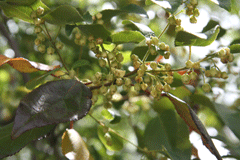
The tree the fungus grows on in the rainforest in Patagonia.
[COOL FIX THEME]
MARTIN: When you hear the word fungus, you probably think of mushrooms - or the stuff that grows between your toes after walking barefoot in a locker room. But when scientists from Montana State University hear the term fungus, they think of diesel fuel. That’s because they’ve discovered a fungal species that produces hydrocarbons identical to many of those found in diesel. The scientists believe this fungal fuel – or myco-diesel - could be put directly into diesel car engines with little or no need for modification.
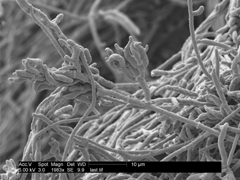
Fungus photo taken with a scanning electron microscope. The image is 5000 times the size of the actual fungus.
The fungus was first found in the Patagonia rain forest, where it grows on trees. It feeds on the trees’ organic matter – including cellulose, the part of plants that animals can’t digest - And it turns that cellulose into diesel. That’s exciting news to scientists because cellulose is a major component of every plant on earth and can be grown with minimal input of land, fertilizer and fossil fuels. And while other groups of scientists are working out the details of making ethanol from cellulose, the Montana State team believes that using fungus to make diesel from cellulose will be an easier task.

The tree the fungus grows on in the rainforest in Patagonia.
One small catch is that the researchers aren’t yet sure how efficient the process is. Ultimately, they may end up taking the genes from the fungus and engineering other microbes that could turn cellulose into diesel more efficiently.
In either case, we may soon have to start paying a little more respect to the fungus among us.
That’s this week’s Cool Fix For a Hot Planet. I’m Jessie Martin.
GELLERMAN: And if you have a Cool Fix for a Hot Planet, we'd like to know about it. If we use your idea on the air, we'll send you a sleek electric blue Living on Earth tire gauge. Keep your tires properly inflated and you could save over $280 a year in fuel. That according to a study done at Carnegie Mellon University. Call our listener line at 800-218-99-88, that's 800-218-9988. Or email coolfix—that's one word—at loe.org. That's coolfix@loe.org.
[MUSIC: Kruder And Dorfmeister “High Noon” from G Stoned (G Stone Records 1994)]
The Sea Superhighway
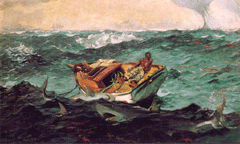
Winslow Homer’s painting “The Gulf Stream,” 1899. (Courtesy of the Metropolitan Museum of Art)
GELLERMAN: A river runs through it – the Atlantic Ocean, that is. While we call it the Gulf Stream, the mighty flow of water off our east coast really behaves like a river in the ocean, writes Stan Ulanski.
Ulanski teaches geology and environmental science at James Madison University and his new book is called “The Gulf Stream: Tiny Plankton, Giant Bluefin and the Amazing Story of the Powerful River in the Atlantic.” Stan Ulanski, thanks for joining us.
ULANSKI: My pleasure to be here. Thank you.
GELLERMAN: You know, we all think we know that the Gulf Stream is but, when I was reading your book I realized I didn’t know what the Gulf Stream was.
ULANSKI: A lot of people have heard about it, but when they really try to define it, they kind of fall short. And really what the Gulf Stream is – it's actually part of a larger circulation in the Atlantic Ocean called a gyre, and the Gulf Stream is one component of it found along the western part of the of the gyre. And essentially what it is is a strong powerful, warm ocean current that starts in the southern part of Florida and flows along the Eastern Seaboard.
GELLERMAN: You write that the Gulf Stream is a wonderful place for sea life.
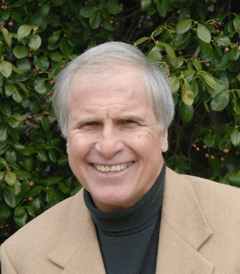
(Photo: Linda G. Bell)
ULANSKI: Absolutely. It’s a conduit, the sea highway, for many, many organisms that basically are tropical organisms. Most of these have no means of moving, like the tiny plankton, they literally go along with the flow. Then you have massive, giant bluefin tuna that can reach up to 1000 pounds. They spawn in the Gulf of Mexico and ride the Gulf Stream northward feeding in the fertile, rich waters off the New England coast. And sometimes they’ll travel even all the way to Europe, still riding that same current.
GELLERMAN: It’s not so much a stream, it’s really a river.
ULANSKI: It kind of is like a river. Even though it doesn’t have hard and fast banks, it does flow quite swiftly compared to its surroundings.
GELLERMAN: Boy, I’ll say. You write in the book, you say, it transports more than two billion cubic feet of water every second.
ULANSKI: That’s absolutely right. When you, in fact, when you compare the transport of the Gulf Stream compared to the Amazon and any of the other larger rivers throughout the world, it really dwarfs them.
GELLERMAN: And it’s warm. I was surprised that it’s like 80 degrees.
ULANSKI: Yeah, that’s really one of the major characteristics of Gulf Stream. If you were taking the temperatures, you’ll see the water temperatures around it are around 60, 65 degrees. And then you come to the Gulf Stream and maybe just in a short distance of a few hundred yards the temperature will jump up to about 80, 82 degrees Fahrenheit.
GELLERMAN: And it goes deep, I guess.
ULANSKI: The Gulf Stream is – yeah – they think of it as surface current, but actually it extends about 2000 to 2500 feet below the surface, so that if you were down there, it would still pull you along at those great depths.
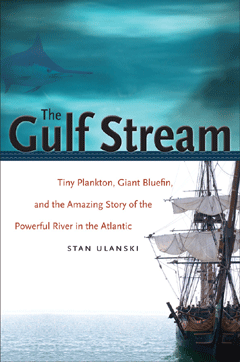
ULANSKI: Well, it’s really a combination of factors. You’ve gotta sort of think of it as a recipe. We’ll take a little bit of the wind, take a little bit of the earth’s rotation, and what you create – you create a hill of water in the center of the ocean as the result of these two factors.
GELLERMAN: When you sail across the Gulf Stream, can you see the difference?
ULANSKI: Very easily. You can see it particularly with regard to its water color. There’s a sharp boundary between the bluish green water that is near the coast and the cobalt blue water of the Gulf Stream. And the other thing that you can see is water clarity. The coastal waters are kind of murky in appearance while the Gulf Stream is really almost really gin clear.
GELLERMAN: You actually flew over the Gulf Stream in a small plane.
ULANSKI: I did fly over the Gulf Stream, just to get sort of a more personal view of it. I’ve been on the Gulf Stream, sailed on the Gulf Stream, worked on the Gulf Stream, dove under the Gulf Stream and I said, Hey – might be kinda of interesting to take it from a different perspective, a bird’s eye view.
GELLERMAN: You really got a passion for this stream.
ULANSKI: Well, yes. Over the years I’ve developed a real passion, and to be honest with you, a real concern and love of the Gulf Stream. It’s probably one of the last vestiges of wilderness on the earth.

Winslow Homer’s painting “The Gulf Stream,” 1899. (Courtesy of the Metropolitan Museum of Art)
GELLERMAN: Well, you share your interest in the Gulf Stream with Benjamin Franklin.
ULANSKI: Oh absolutely. In fact, he took three cruises across the Gulf Stream taking in depth measurements not only at the surface, but also at the depth. And he produced one of the first maps of the Gulf Stream that was used extensively by both American and English merchants.
GELLERMAN: So if I was off the coast of Florida, put a message in a bottle and dumped it into the Gulf Stream, where did you think it would wind up?
ULANSKI: That’s a real good question, in fact, that’s how scientists really first started to study currents. They put the old proverbial message in a bottle and tried to track them. Now what they use are called little drift packets, just plastic envelopes where they put a little note in and put it in water and hopefully if somebody picks it on up, they send it back with the information of where they got it, when they got it, and so on. So we still use this proverbial message in a bottle to track currents.
GELLERMAN: Did you ever drop a message in a bottle?
ULANSKI: [Laughs] No, I never did. I did put current meters in, ah, but the meters we put in were sort of stationary where we measured the Gulf Stream and other currents from the surface downward.
GELLERMAN: I like when you say in the book, if Christopher Columbus discovered the new world, Ponce de Leon discovered the way back.
ULANSKI: Yeah, that was really, really, really critical. As the Portuguese and the Spanish started to move towards the New World looking for gold particularly, it was important to get back, and how would they get back? Because one of the critical things was they would be going in cases against the winds, particularly in the trade winds. And so Ponce de Leon, though he wasn’t looking for the way back, he was fortuitous while searching for gold in Florida, found the Gulf Stream.
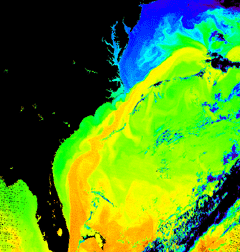
The warmer current of the Gulf Stream flows to the northeast off the U.S. eastern seaboard. (Image: Donna Thomas/MODIS Ocean Group, Courtesy of NASA)
ULANSKI: The pirates knew that the Spanish galleons leaving from Havana would have to take the path back between Florida and the Bahamas, so they actually set up a number of outposts and plundered ships for decades.
GELLERMAN: Global warming is now affecting the planet. How is it affecting the Gulf Stream?
ULANSKI: Boy, that’s really a big can of worms both politically and scientifically. One school of thought goes that if the Gulf Stream stopped you could lead to an ice age. Or the other thing goes global warming will lead to an ice age. But let me try to explain this as simply as I can. Ultimately, the Gulf Stream is not an entity in itself. It’s part of a larger global conveyor belt. This global conveyor belt is kind of like the earth’s thermostat. It flows throughout the globe both at the surface and at the deeper parts, and it moves water - both warm and cold water. So the idea if this conveyor belt stopped, well then, temperatures would change. If you had global warming, that could lead to melting of the ice caps and the glaciers - puts a tremendous amount of fresh water in the North Atlantic. This fresh water would decrease the density of the Gulf Stream, and so part of the Gulf Stream that sinks would no longer sink and therefore that whole conveyor belt would be disrupted and, the scenario goes, if you disrupt the conveyor belt, you prevent some of the heat being transported, hence the beginning of the ice age. In fact, some people believe that’s how the ice ages have occurred. The conveyor belt has been interrupted.
GELLERMAN: It’s interesting that something so big and so powerful has drawn so little public interest.
ULANSKI: You’re absolutely right. Again, it’s drawn a lot of scientific interest, but scientists basically write for other scientists. And I think one of my goals was to sort of get the Gulf Stream out of its sort of narrow point of view and bring it to a bigger audience.
GELLERMAN: Well, Professor Ulanski, thank you so very much,
ULANSKI: It was my pleasure, thank you.
GELLERMAN: Stan Ulanski is a professor of geology and environmental science at James Madison University. His new book is called “The Gulf Stream.”
Related links:
- For more about Stan Ulanski and his book, click here
- To learn more about the Gulf Stream, check out the Cooperative Institute for Marine and Atmospheric Studies’
[MUSIC: Azymuth “What Price Samba” from Telecommunicacion (Fantasy/Milestone 1982]
GELLERMAN: Coming up: renewing a nation ripped by civil war with renewable radio. Keep listening to Living on Earth.
ANNOUNCER: Support for the Environmental Health Desk at Living on Earth comes from the Cedar Tree Foundation. Support also comes from the Richard and Rhoda Goldman fund for coverage of population and the environment. And from Gilman Ordway for coverage of conservation and environmental change. This is Living on Earth on PRI, Public Radio International.
After War, Wind-Powered Radio
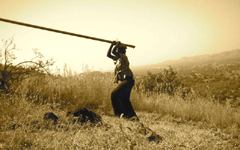
A local woman carries part of a windmill up Kauda mountain to power her local radio station. (Courtesy of Internews)
GELLERMAN: It’s Living on Earth. I’m Bruce Gellerman.
[SOUND OF RADIO MUSIC BROADCAST]
GELLERMAN: From one of the most remote places on the planet, a familiar sound – radio - a critical link, empowering the people of southern Sudan.
[SUDAN RADIO: This is the voice….[foreign language] This is your community radio.]
GELLERMAN: For more than two decades southern Sudan was the scene of one of the longest lasting wars of the 20th century. Before it ended three years ago, nearly two million civilians were killed and four million southerners were forced to flee their homes. Now people are returning and radio is helping to heal the nation. John Mussa is a reporter with Internews in southern Sudan. Internews is an international nonprofit organization that works to improve access to information for people around the world by fostering an independent media.
MUSSA: Nuba Mountain is a part of Sudan. It has never seen a development before and after independence of Sudan. It was the dream of a number of people to have radio. Because it's a simple way to give a message.
GELLERMAN: In the case of Sudan, Internews built four radio stations in the civil-war-torn south, and powers them with sustainable, renewable energy.
Deborah Ensor is Internews’s program director in Sudan.
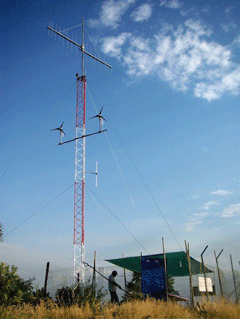
This transmission tower had to be located at the top of Kauda Mountain to broadcast to a larger local audience. (Courtesy of Internews)
ENSOR: Since the war ended in south Sudan about three years ago, there’s no real infrastructure here, there’s no way for people to get information. There’s not a lot of printing presses, there’s not a lot of newspapers. A lot of people can’t read because there hasn’t been schools in south Sudan for many, many years. So radio is a really great way to reach people.
GELLERMAN: Radio is a really powerful medium, but how do you get power for your radio stations?
ENSOR: As I was saying earlier, there’s no infrastructure in south Sudan or very limited infrastructure. Which means there’s no electricity. So everything is powered by generators, and generators are expensive and they’re somewhat difficult to maintain. So in some of our stations we use solar and wind power. Sudan is a very hot place. It’s very dry half of the year, and so the sun is a really, really great way to power some of the stations.
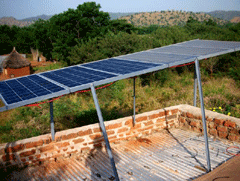
100 percent of the power for the Kauda station’s transmission tower comes from sun and wind, while the radio station in the valley uses solar panels backed up with generators. (Courtesy of Internews)
GELLERMAN: Some of these radio stations are located in incredibly remote mountainous regions.
ENSOR: Yes. Our station in Kauda which is in the Nuba Mountains in south Sudan is a very remote location. It’s very mountainous. So when you’re trying to send out a radio signal, it’s very limited in its range because there’s so many mountains around, it just sort of gets stuck in the valley. So we had to put our transmission tower in a remote transmission site, so way up on top of this hill in the mountains. Getting it up there was a whole 'nother matter in and of itself. We had over a ton of equipment that had to go on the top of this mountain, including six batteries that weigh about 60 kilograms a piece, four mast sections, more than 50 kilograms of tools, every day that had to go up and down. It’s like a 90 minute hike to get up the hill. The temperature is 105, 110 degrees. And there’s no vehicles that can go up there. So we hired a lot of local women from the community. They carried up all of the equipment - something like 20 kilos per load on their heads. And it’s amazing. I would go up this hill and I would be so plum tuckered by the time I got up there and I’m not even carrying anything, but myself and a bottle of water, you know. And these women are carrying 20 or 30 kilos on top other their head and they’re walking barefoot or in sandals, and they’re laughing and singing along the way, and it was very easy for them.
GELLERMAN: Deb, why women? Didn’t the men do this?
ENSOR: You know the men did other jobs. The men carried the batteries because it took four men to carry one battery because they’re so heavy. But generally speaking, women do a lot of the work.
GELLERMAN: You sent us some audio from going up this mountain. Let’s listen to it now.
DOBBING: We’re just approaching the roof of the community mast on top of the mountain.
ENSOR: This is Ellie Dobbing. She’s our media training manager.
DOBBING: We’ve walked up to look at it. [Panting] You can hear the wind turbines spinning. [Walking]
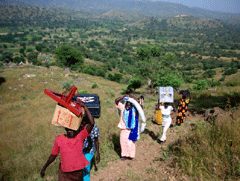
Local women carry supplies to a new transmission tower at the top of Kauda Mountain. (Courtesy of Internews)
GELLERMAN: So Deb, how do people power their radios, if there’s no electricity available?
ENSOR: There’s several NGOs that give out radios as part of their projects and they are these terrific little solar powered and hand crank radios.
GELLERMAN: I understand you have a power with roaming cows and goats affecting the station. How’s that?
ENSOR: [Laughs] Yeah, well, you know, all of these areas are agricultural areas. Everyone has cows, everyone has goats. They just sort of free roam anywhere and [laugh] you’re trying to record on the air and you can hear in the background the bleating of goats, you know, the feet of cows padding by. So you have to be very careful when you’re setting up sensitive equipment to make sure that it’s fenced off very well so that roaming animals don’t destroy it by accident.
GELLERMAN: Deb, this is community radio that you’re doing, this is run by the people who live there. Have they ever done community radio, or any radio?

A local woman carries part of a windmill up Kauda mountain to power her local radio station. (Courtesy of Internews)
[SUDAN RADIO: FOREIGN LANGUAGE, DRUMMING]
ENSOR: The communities are just thrilled with these stations, you know, they’re so excited to hear them. It’s fantastic, just the enthusiasm and the excitement for people to be able to hear radio and to hear it in their own language. We broadcast in more than ten different languages.
[SUDAN RADIO: VOICES IN FOREIGN LANGUAGES, MUSIC]
ENSOR: It provides them with information about so many things, things like early marriage and why is it important for young girls to stay in school, you know, if there’s a malaria outbreak, the station informs what to do and where it’s happening. And there’s a lot of really funny, great, wonderful little things too. You know, they have these community hours where people in the community can just come to the station and make announcements on the air. They talk about their lost cows, they come in to sing folk songs, and they just really grasp on to it and really participate.
GELLERMAN: I’ve consulted with Internews overseas and I’ve worked with them with setting up radio stations around the world. Where does it go from here, Deb?
ENSOR: What we’re trying to do is build the capacity of the staff and of the community to be able to run the station on their own. The idea is that at the end of the day Internews will leave and these stations will remain behind and there’ll be a cadre of journalists that are able to put together accurate and fair and interesting information for their communities and that they can do it on their own.
GELLERMAN: Deborah, thanks a lot. Appreciate it.
ENSOR: Thanks a lot, Bruce. I appreciate it too.
[RADIO SOUND]
GELLERMAN: Deborah Ensor is Program Director for Internews in Sudan, where the wind and sun are powering radio stations and empowering people.
Related link:
Internews Website
Toy Toxicity

Cheap plastic children’s jewelry is five times more likely to contain elevated levels of lead than other toys. The pieces are often small enough to be ingested, delivering their toxic load to a child’s stomach. (Photo: David C. Brewster)
GELLERMAN: Well ‘tis the season for Santa and shopping trips to toy store. ‘Tis also the season for scary stories about toxic toys and the safety of gifts for kids. This year, for the second time, the non-profit Ecology Center in Michigan has come out with its healthy toys list – it’s a hit list of sorts for the holiday season.
Jeff Gearhart is the toxic campaign director for the Center.
GEARHART: Well, we tested about 1500 toys and the funny thing about toys is they don’t come with ingredient lists. You can go to the grocery story and look at food or cosmetics or many other products and you can find out what’s in them. With toys, you don’t know.
GELLERMAN: So you actually test the toys to see what they’re made of.
GEARHART: Yeah. We conducted close to 50,00 tests on the toys and we identified nine different chemicals in the toys that we consider chemicals of concern. And these include obvious things like lead and mercury and cadmium as well as a handful of other chemicals that we’re concerned about.
GELLERMAN: Well what was the number of toys out of the 1500 that you tested that you considered unsafe?
GEARHART: We found that one third of the toys we tested had significant levels of the chemicals of concern that we looked at.
GELLERMAN: One third?
GEARHART: Yeah. So that’s the bad news, that’s entirely too many.
GELLERMAN: I see that topping your list of the ten worst toys for lead, there’s the Disney three heart and HM graphic necklace. A Hannah Montana toy, and my kid loves Hannah Montana. Should we not get this?

Legos were found to be made from a plastic that is safe for children.
GELLERMAN: I noticed that on your list, number five is the Wii by Nintendo.
GEARHART: Many electronics, game consoles as well as items you would not consider toys, TVs and stereos and other electronic components use flame retardants in circuit boards and other components of the electronics. And we actually found more of these compounds this year than we did last year. And that’s why we’re pushing for more broader regulatory reform.

Cheap plastic children’s jewelry is five times more likely to contain elevated levels of lead than other toys. The pieces are often small enough to be ingested, delivering their toxic load to a child’s stomach. (Photo: David C. Brewster)
GELLERMAN: Well last year Congress actually responded to your list and they’re going to change things in 2009. Now that’s next year.
GEARHART: Yes. The Consumer Product Safety Improvement Act was passed this year. Its main provisions will come into effect on February 10th of 2009. All of the products that would be illegal under that regulation are actually on the shelf right now.
GELLERMAN: Now, who are the villains in this? I mean where are these products that are unsafe coming from?
GEARHART: About 80 percent of the products we tested and 80 percent of the products from the market are from China. But when we look at the statistics in terms of where we’re finding high amounts of lead or other chemicals, we actually don’t see a significant difference. The point we like to emphasize is that this is a wholesale problem and we’re seeing toys coming from all over the place with elevated levels of lead.
GELLERMAN: Well you tested 1500, toys, two-thirds of them are not bad. What are some of the good ones?
GEARHART: We recommend unpainted wood toys, the fabric toys, and plush cloth toys are good choices. And as I said before, avoiding children’s jewelry is another good choice people can make.
GELLERMAN: Well Jeff I want to thank you very much. I appreciate it.
GEARHART: Thanks for having me on.
GELLERMAN: Jeff Gearhart is the toxic campaign director of the Ecology Center – you’ll find a link to their list of safe and unsafe toys at our website – loe.org
Related links:
- Click here to see toy results
- The Ecology Center
A Wild Xmas
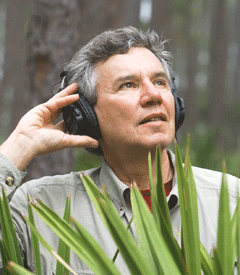
Bernie Krause (Photo: Tim Chapman)
[MUSIC: Phil Aaberg and Bernie Krause, "Jungle Bells Fantasy" from 'Wild Christmas' (Miramar—1998)]
The tune's familiar. But you won’t be hearing this version of the holiday standard in your neighborhood shopping mall. No. This one is from nature herself. It’s on a compilation called “Wild Christmas.” It was released back in 1991 by Phil Aaberg and Bernie Krause. The album has long been out of print but you can download it from the Internet.
KRAUSE: This album really consists of just animal sounds. There are no synthesizers, no traditional instruments. And we managed to put this together by going through this large archive of material that I have and finding ones that kind of fit the voices of more traditional music instruments.
[SQUEAKING TO THE TUNE OF 'DECK THE HALLS']
KRAUSE: The intro is made of dolphins.
[SQUAWKING OF 'FA LA LA LA LA LA LA']
KRAUSE: And of course the 'la las' are a parrot: Molly the parrot.
[THUMPING NOISE]
KRAUSE: And you have the baby mountain gorilla that was recorded in the late Diane Fossey's camp at Karisoke in Rwanda.
[GROWLING AND SNAPPING SOUNDS]

Bernie Krause (Photo: Tim Chapman)
KRAUSE: And you have the snapping fish tapping on the music stand saying 'come on guys, let's get it together.' We would take a parrot or a walrus and we'd sample the sound. We'd do a small recording, a short recording of each of those voices, and then we'd put it into a MIDI synthesizer, establish a range of frequency around it - like, maybe two octaves for the walrus or an octave for the parrot - and give it an octave range. And then we would just play it like we play a normal instrument.
[FA LA LA, CHIRPING AND BUZZING]
KRAUSE: One of the neat things about 'Amazing Grace' is that it begins with sounds that are recorded in the Amazon at a place called Kilometer 41, which is a research station north of Minais, which is kind of midway in the Amazon.
[DEEP BLOWING SOUND AND CHIRPING, TUNE OF AMAZING GRACE]
KRAUSE: And there's also a bird there called the Common Potoo. And a Common Potoo is a melodic bird that does kind of a bluesy sound and has a bluesy melody. And so we wanted to include that as kind of a reference point mixed in with all the other animals that you hear in that soundscape.
[COMMON POTOO SINGS MELODY OF 'AMAZING GRACE']
KRAUSE: The key is always to find a way to bring out the Western musicality in these animals. And it's surprising how many animals do have this musical quality.
When we were recording in places like the Amazon or Africa, what we found was that these animals all voice together, all sing together, in relationship to one another—much like instruments in an orchestra. And one of the ways we wanted to bring this to people's attention was through albums like 'A Wild Christmas,' where we actually take the animals and group them together in traditional musical form, so that people can actually hear them singing together.
[WE WISH YOU A MERRY CHRISTMAS]
GELLERMAN: Bernie Krause sampled the natural world for "A Wild Christmas." Living on Earth's Eileen Bolinsky produced our tribute. You can find the music online at www.wildsanctuary.com.
[WE WISH YOU A MERRY CHRISTMAS]
Related link:
"A Wild Christmas" - WildSanctuary.com
On the next Living on Earth – We report from Poznan, Poland. It’s where delegates from around the world are trying to come up a new treaty to deal with climate change and disruption. It won’t be easy, as nations have conflicting demands and priorities - and wait to see where president elect Barack Obama will take the United States. The cold winds of Poland and a warming planet - next time on Living on Earth.
[WE WISH YOU A MERRY CHRISTMAS]
Living on Earth is produced by the World Media Foundation. Our crew includes Ashley Ahearn, Bobby Bascomb, Eileen Bolinsky, Ingrid Lobet, Helen Palmer, Mitra Taj and Jeff Young, with help from Sarah Calkins and Marilyn Govoni. Our interns are Sandra Larson and Jessie Martin. Jeff Turton is our technical director. Alison Lirish Dean composed our themes. You can find us at loe.org. Our executive producer is Steve Curwood.
I’m Bruce Gellerman. Thanks for listening.
[MORE WILD CHRISTMAS MUSIC]
ANNOUNCER: Funding for Living on Earth comes from the National Science Foundation, supporting coverage of emerging science, and Stonyfield Farm: organic yogurt and smoothies. Stonyfield pays its farmers not to use artificial growth hormones on their cows. Details at stonyfield.com.
Support also comes from you our listeners, the Ford Foundation, the Town Creek Foundation, the Oak Foundation supporting coverage of climate change and marine issues; the Skoll Foundation, supporting social entrepreneurs around the world – uncommon heroes dedicated to the common good. Learn more at skoll.org; and Pax World Mutual Funds: socially and environmentally sustainable investing. Pax World: for tomorrow. On the web at paxworld.com.
ANNOUNCER: PRI, Public Radio International.
Living on Earth wants to hear from you!
Living on Earth
62 Calef Highway, Suite 212
Lee, NH 03861
Telephone: 617-287-4121
E-mail: comments@loe.org
Newsletter [Click here]
Donate to Living on Earth!
Living on Earth is an independent media program and relies entirely on contributions from listeners and institutions supporting public service. Please donate now to preserve an independent environmental voice.
NewsletterLiving on Earth offers a weekly delivery of the show's rundown to your mailbox. Sign up for our newsletter today!
 Sailors For The Sea: Be the change you want to sea.
Sailors For The Sea: Be the change you want to sea.
 The Grantham Foundation for the Protection of the Environment: Committed to protecting and improving the health of the global environment.
The Grantham Foundation for the Protection of the Environment: Committed to protecting and improving the health of the global environment.
 Contribute to Living on Earth and receive, as our gift to you, an archival print of one of Mark Seth Lender's extraordinary wildlife photographs. Follow the link to see Mark's current collection of photographs.
Contribute to Living on Earth and receive, as our gift to you, an archival print of one of Mark Seth Lender's extraordinary wildlife photographs. Follow the link to see Mark's current collection of photographs.
 Buy a signed copy of Mark Seth Lender's book Smeagull the Seagull & support Living on Earth
Buy a signed copy of Mark Seth Lender's book Smeagull the Seagull & support Living on Earth

